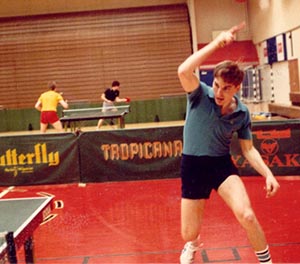Tip of the Week
Looping to the Forehand, Backhand, and Middle.
Another Brutal Weekend
Sixteen hours of coaching on a weekend is brutal. I can personally attest to this – and as usual, I’m feeling the aftermath on Monday. Okay, it’s brutal for me, but just another couple days at the office for many of my workaholic fellow coaches, who do this six days a week and have this much energy.
What made things worse was a silly sort of mishap on Saturday. After doing five hours of private coaching, we had the Saturday night junior league, 6:30-8:30PM. It’s really sort of a misnomer as it’s a combination of league and coaching. For me, it was a nice break – after standing up for five hours, I got to sit down for most of the first hour, watching and taking notes of our players for future use. But here’s where the silly mishap happened – I stood up. Yes, I was sitting in a chair, and I stood up, and pulled something in my left leg. Really.
So I hobbled about for a while, and then we finished the session with doubles. Surprise – to even things out, they put me down for doubles with one of the players! I had neglected to mention to them that I’d hurt my leg. I decided I could do it, so went out and played – and of course aggravated it a bit. (Add the fact that I had no warm up, and let’s just say it took me a game or two to get going, and then it was hobble and loop.)
So on Sunday, where I had even longer hours, I found myself favoring the leg – which led to me straining my back. Yes, that’s how it starts – one injury leads to another. I went through most of the day okay, but toward the end I almost brought in another coach to substitute. However, I made it to the end, which fortunately ended with 4.5 hours of group sessions (so I could hobble about without having to run down balls).


 Photo by Donna Sakai
Photo by Donna Sakai


